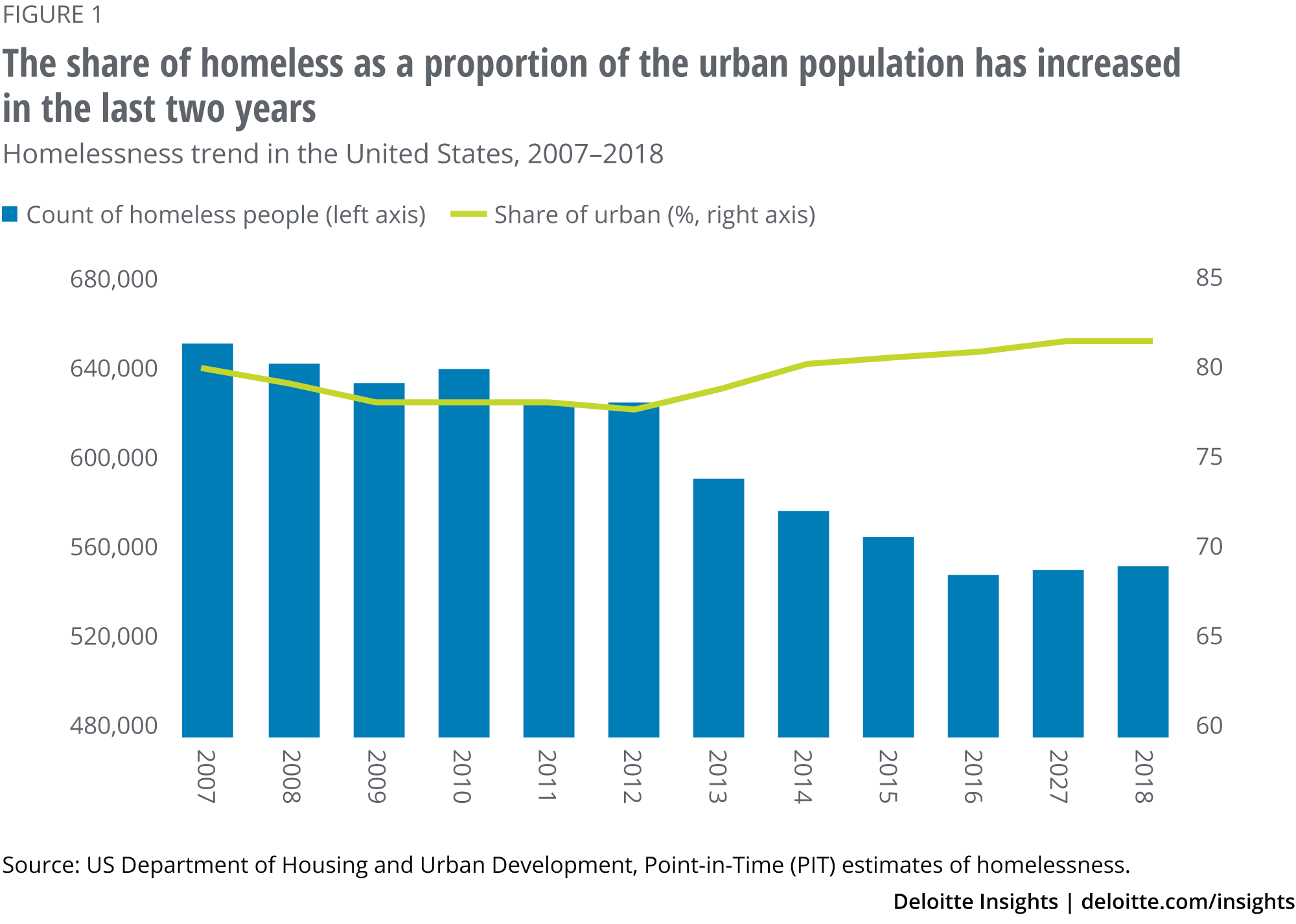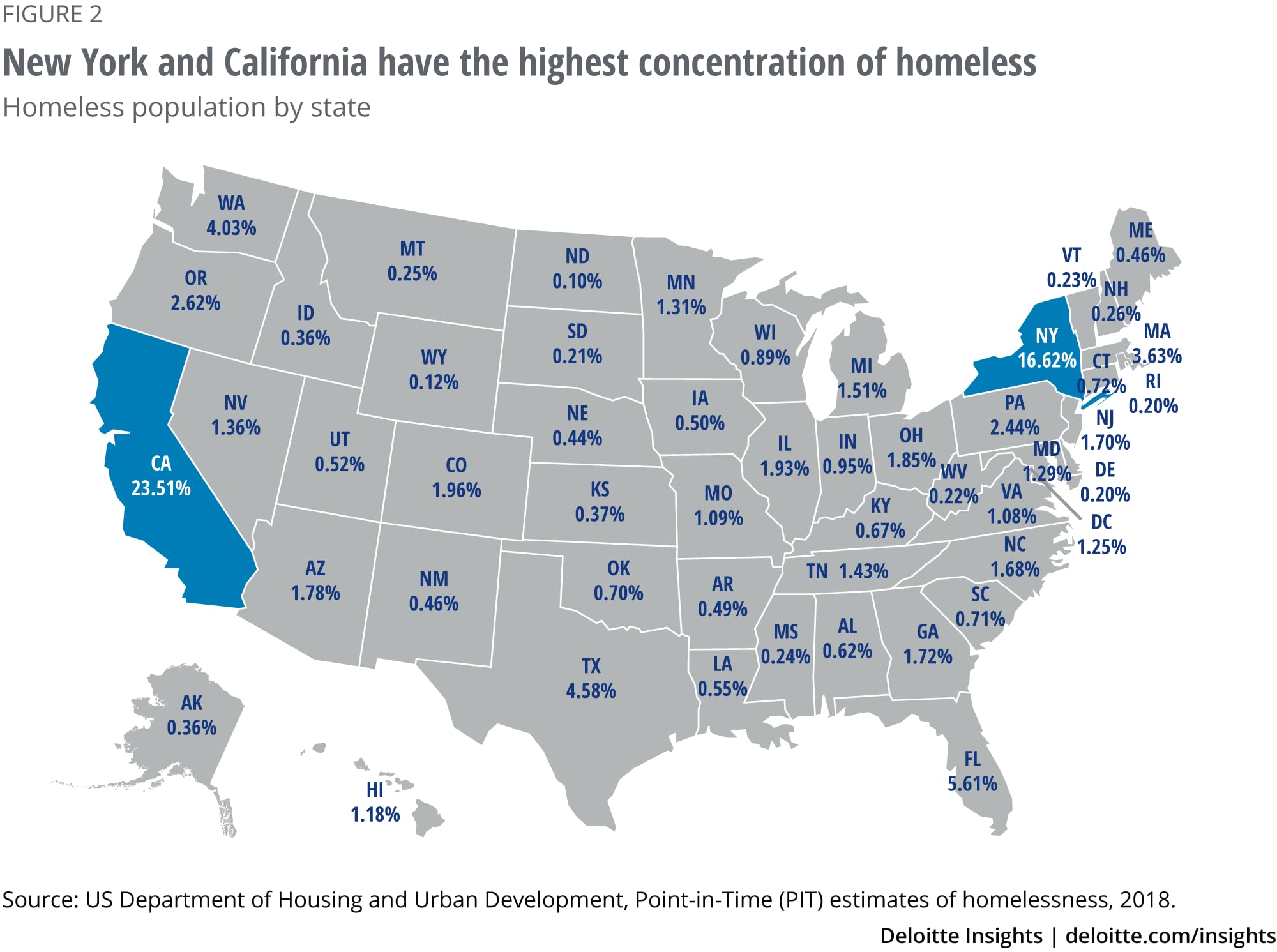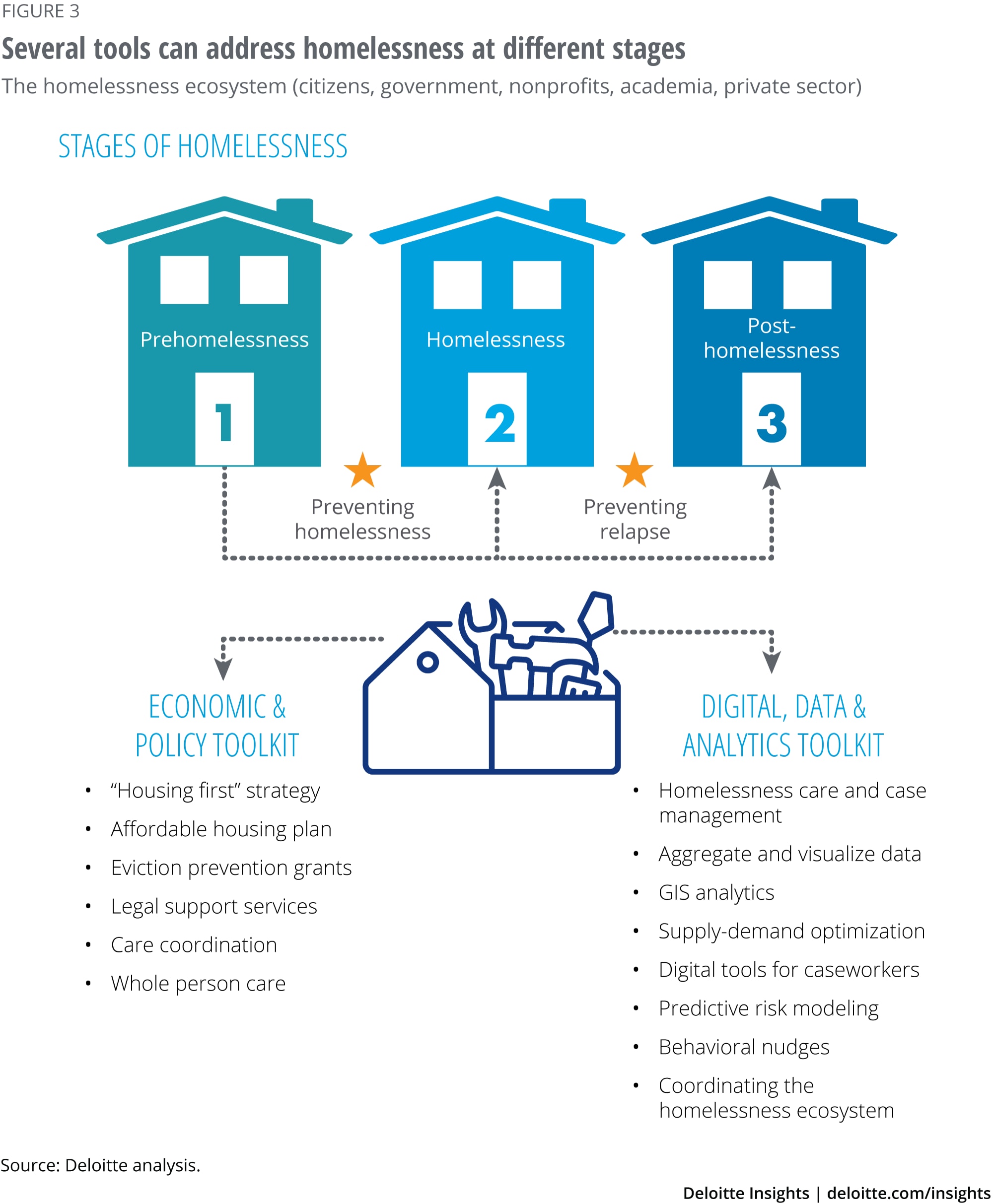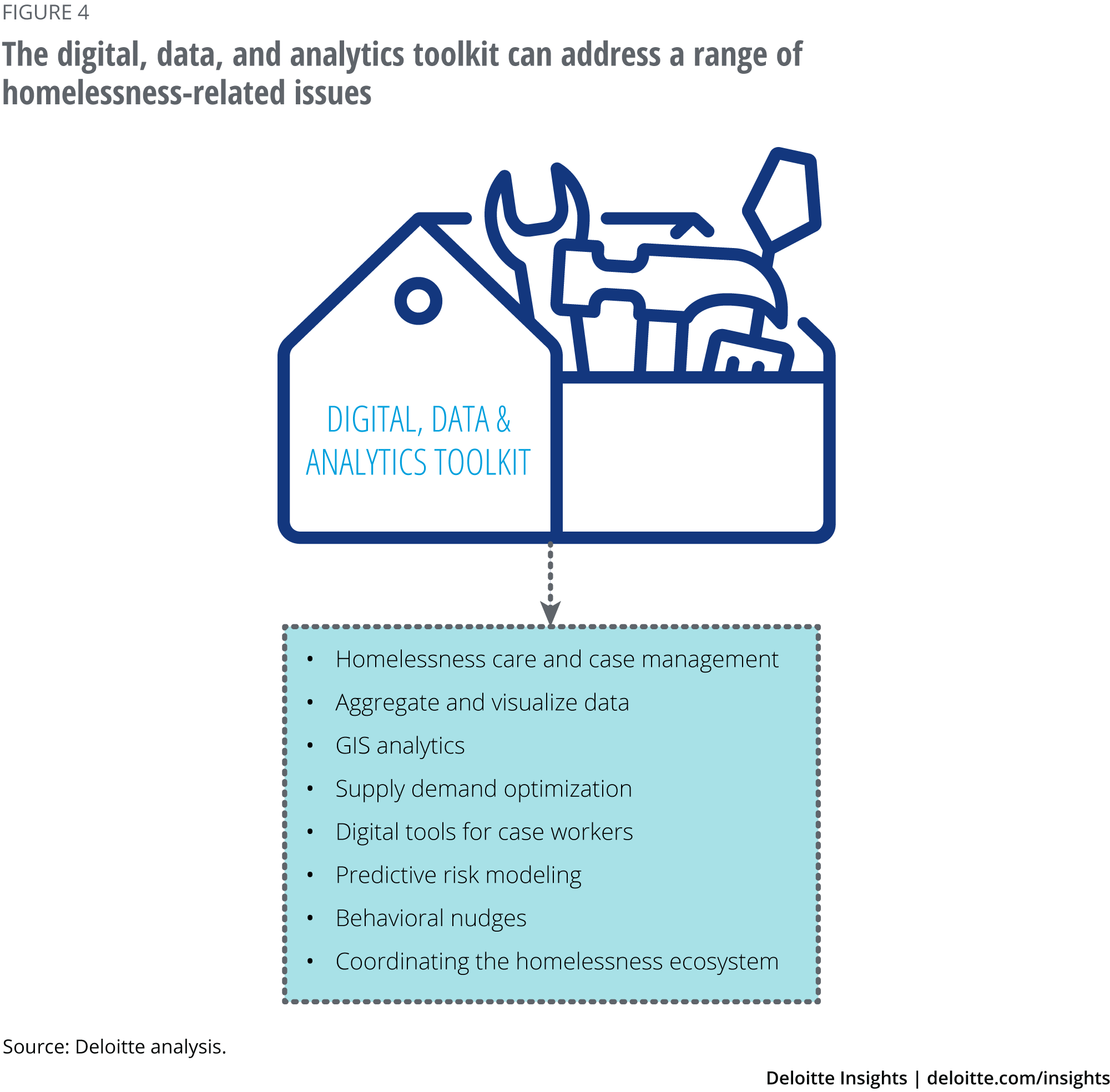
Addressing homelessness with data analytics A data-driven approach to homelessness
12
25 September 2019
While traditional approaches have helped policymakers reduce homelessness to an extent, technology and data analytics can help them go a step further in dealing with the country’s homelessness problem.
Every year in January, an army of volunteers braves the cold winter night to count America’s unsheltered homeless population. These volunteers fan out across the nation, looking for people in parks, under bridges and highway overpasses, in train stations, and any other places with possible encampments. This mammoth exercise is the federal Department of Housing and Urban Development’s (HUD’s) annual “Point-in-Time” homeless count, the largest attempt to quantify homelessness in America.1
Learn more
Read the related article, The homelessness paradox
Read more about smart cities
Subscribe to receive related content from Deloitte Insights
Download the Deloitte Insights and Dow Jones app
Although the annual homeless count has been criticized for possibly underestimating the scale of homelessness and disregarding large numbers of Americans on the verge of homelessness,2 the HUD data can be useful for analyzing trends. It reveals three key insights: First, despite a strong economy, homelessness inched up in 2017 and 2018 (see figure 1), reversing a previous downward trend. Second, homelessness in the United States primarily affects urban communities, with about 82 percent of the homeless population in urban areas. Finally, homelessness isn’t distributed evenly (see figure 2): The Los Angeles and New York Continuums of Care (CoCs), for example, accounted for 23 percent of all homeless people in the nation in 2018.3 (A CoC is a local or regional planning body organized under HUD.)
The good news is that technological advances and data insights are giving policy leaders new tools in the fight against homelessness. Traditionally, entities combatting homelessness—governments, nonprofits, and community service organizations—have applied a variety of policy and economic approaches to address homelessness. These tools continue to be important, but today, their impact can be magnified by combining them with digital and data analytics tools.
This article focuses on the power of data analytics and digital technologies that can tackle homelessness, particularly in urban areas. Thanks to these technologies, we can target resources for the homeless more effectively and can use predictive analytics to better assist those at risk of becoming homeless.


Traditional and emerging tools to address homelessness
Homelessness can be a result of wage stagnation, mental illness, lack of affordable housing, various forms of discrimination, lack of economic opportunities, addiction, and other such factors that have been explained in our article The homelessness paradox: Why do advanced economies still have people who live on the streets? Tackling homelessness in its entirety requires taking into account the three stages of homelessness:
- Stage 1: People at risk of homelessness.
- Stage 2: People who are currently homeless.
- Stage 3: People who have found a home but may need help to keep it.
Most efforts to fight homelessness are focused on stage 2, given its urgency, but the other stages also should be addressed. Two sets of tools can help government leaders, policymakers, and social service agencies address homelessness at each of these stages:
Policy and economic tools. These include traditional approaches to reduce the number of people experiencing homelessness. For example, eviction prevention grants and other legal and support services are offered to prevent homelessness in the first place. The “housing first” strategy, which has garnered bipartisan support, is designed to focus on those at risk (stage 1) as well as those who are already homeless (stage 2). (See the sidebar “‘Housing First’ and other policy-driven preventive mechanisms.”) A variety of job training and substance treatment programs can help to prevent a return to homelessness (stage 3).
Digital and data analytics tools. These use technology to help homelessness-focused agencies become more effective on the ground (figure 3). This toolkit can amplify and refine traditional approaches. For example, a case management system that uses data analytics and digital solutions to track, monitor, and support people across all three stages of homelessness can be a game-changer for urban communities.

“Housing first” and other policy-driven preventive mechanisms
The roots of the “housing first” strategy can be traced to the city of New York’s right to shelter mandate of the 1980s. This mandate required the city, which has the nation’s second-highest homeless population, to provide temporary emergency shelter for every eligible constituent every night. Since then, the city has followed the mandate through a patchwork of options including private apartments and “cluster rooms” in hotels. Many states have adopted similar programs, producing a rising number of permanent housing options across the country.4
A housing first strategy can be implemented in various ways:
Permanent supportive housing (PSH) provides affordable housing and support services to individuals experiencing mental illness, HIV/AIDS, and other serious health issues. In 2017, for example, Los Angeles County used PSH to permanently house more than 16,000 people—more than any other jurisdiction in the nation in that year.5
Rapid rehousing, a relatively new model, focuses on helping people find a home as quickly as possible, thereby giving them space to tackle other challenges such as employment, education, and health care. Rapid rehousing thus shifts the initial focus away from preconditions such as income, addiction, or a criminal record and toward first providing housing. Y-Foundation, a Finnish organization, used this approach to provide more than 6,000 homes for the chronically homeless and 10,000 homes for low-income individuals and families. Its efforts helped cut chronic or long-term homelessness in the nation by 35 percent from 2008 to 2016.6
In addition to “housing first,” two other noteworthy measures can aid people at risk of homelessness. Eviction-prevention grants provide financial assistance to persons struggling with rental arrears due to a sudden event such as illness, death in the family, or unemployment. Legal assistance for low-income tenants in housing courts reduces the asymmetry in access to legal services between low-income tenants and landlords.
Exploring the digital and data analytics toolkit
Technology can enhance coordination among different players, including governments, the private sector, social enterprises, community organizations, and citizens, supplementing traditional approaches to reducing homelessness.
Let’s see how an integrated care and case management system can provide a starting point for homelessness-focused agencies, and how a coordinated entry system (CES) can integrate data from multiple sources, both internal and external, to help them develop more effective solutions (figure 4).

Homelessness care and case management: Coordinated data entry for homelessness
The Homeless Emergency Assistance and Rapid Transition to Housing (HEARTH) Act was an important piece of legislation passed in 2009. With the homelessness population growing in the wake of the 2008 economic crisis, it was important to take a focused approach to end homelessness. A year later, in 2010, the White House and the US Interagency Council on Homelessness (USICH) released a strategic plan to prevent and end homelessness called Opening Doors.7 The plan focused on ending homelessness for four specific cohorts: families with children, youth, veterans, and the chronically homeless.
With the passing of the HEARTH Act, HUD mandated a CES for all CoCs.8 This was an important shift toward collecting and managing homelessness data across the United States. Before the mandate, each CoC was collecting homelessness data in its own customized homelessness management information systems (HMIS).
The emergence of the CES has helped address one of the most critical issues faced by many urban communities across the United States: coordinating support services across the three stages of homelessness. The integration of homelessness data from entry to exit and beyond provides CoCs with a broader view of the problem, providing the data needed to drive insights and decision-making. More importantly, it has helped refocus resources on families with children, youth, veterans, and the chronically homeless. These systems enable CoCs to achieve three things:
Increase customer focus. Homelessness-focused agencies can now focus on the “person” coming into the system. A streamlined entry process focuses on understanding the client needs and determining the right program for them, whether a supplemental nutrition assistance program or a mental health services program.
Prioritize vulnerable clients. The system focuses on understanding the vulnerability of the person coming in. Through a series of questions focusing on the history of housing and homelessness, health risks, physical abuse history, legal issues, financial history, and social relationships, a homelessness agency can understand the severity of the situation. Thus, an agency can target the right population at the right time with the right services.
Build a data-driven system. A CES can help integrate data across the homelessness life cycle. This data can provide a starting point for understanding the state of homelessness and, more importantly, drive data-driven decision-making.
Aggregate and visualize data: Integrating homelessness data to drive insights
Is there a dearth of data on homelessness? No. HUD collects annual point-in-time data and housing inventory count data for all CoCs across the United States. A separate HMIS contains data collected by each CoC. The National Center for Homeless Education also maintains a database on the education of homeless youth. Data is collected at the state and local levels too. This data, however, often sits in jurisdictional silos, making it hard to use it to see the whole picture.
However, some attempts have been made to make sense of the reams of data that are available and use them meaningfully. The Los Angeles Homeless Services Authority (LAHSA), for instance, has collected and visualized homelessness data on different cohorts of the homeless population, including adults, families, veterans, and youths. Its winter shelter program dashboard provides information on average occupancy at each winter shelter in the city and county of Los Angeles.9 These dashboards can help LAHSA identify shelter vacancies and allow community service organizations to match people experiencing homelessness with available shelter space.
Similarly, the National Alliance to End Homelessness has a “State of Homelessness” portal that aggregates and visualizes homelessness data drawn from across the nation.10 In addition to tabulating the number of people experiencing homelessness, the portal can be used to examine sheltered versus unsheltered populations, homelessness by race and ethnicity, the availability of beds in each state, and trends in permanent housing solutions. Such open data portals can help gauge the success of various initiatives and highlight communities that are reducing homelessness. These insights can help refocus resources to appropriate geographic regions and cohorts, both locally and nationally. However, local agencies haven’t yet been able to integrate data in this way.
GIS analytics: Using location-based technology to locate homeless populations
Location-based capabilities represent a natural next step toward enhancing the value of homelessness data. They can help governments answer critical questions: Where are large pockets of homeless located? Where is the housing stock available? Which areas should caseworkers prioritize?
Identifying an ever-moving homeless population can be difficult. Mobile and GIS technologies, however, can collate real-time location data from caseworkers and citizens. LAHSA, for instance, has launched an online Los Angeles County Homeless Outreach Portal that allows community members to report on homeless persons who need help. When a resident sees homeless persons on the street, he or she can report their location on a map, add other details, and send a request to the homelessness outreach team. Based on this data, the outreach team can try to connect the person experiencing homelessness with different services.11
Supply-demand optimization: Using data to match people to affordable homes
Many people in the United States become homeless due to a lack of affordable housing or through eviction.12 Other nations receive a steady flow of refugees from war-torn and unstable countries. Many of these migrants are employable and can find jobs, but need help finding affordable homes. This group can be prevented from falling into homelessness if they are helped with finding affordable homes quickly.
Canada, for instance, opened its borders to 25,000 Syrian refugees between December 2015 and March 2016.13 WoodGreen Community Services, a Toronto social service agency, launched the Housing Opportunities & Marketplace Exchange (HOME) online portal to help these migrants find homes in the greater Toronto area.
The HOME portal is a user-friendly website that allows individuals and businesses to list houses and other services on the website. In a few simple steps, migrants can register on the portal, search for listings, quickly locate the homes or services they require on a map, and contact donors or landlords directly. Since its January 2016 launch, the portal has helped at least 149 families find homes at rental rates 5–15 percent lower than the market rate. The portal also helped the government save more than US$8.63 million annually on subsidized housing. Based on its success, the HOME portal was expanded to include the city’s homeless population.14
Digital tools for caseworkers: Making data-driven decisions
Data insights also can help government agencies and outreach workers make their operations more efficient. For instance, one of the most important outcomes of building a CES for homelessness is the ability to prioritize clients based on their vulnerability.
Moreover, such data systems are available to outreach workers in the field. For instance, San Francisco’s online navigation entry system allows outreach workers to access homelessness data via a mobile app.15 The app also helps workers locate, assess, and connect the homeless with the right services. A similar tool in the West Sacramento Outreach Grid provides outreach workers with locations of homeless camps and provides access to homelessness data to help them make decisions on the spot.16
Predictive risk modeling: Helping those at risk of homelessness
The idea that the government should focus more on preventing problems instead of fixing them isn’t new, of course.17 Today, however, advances in data analytics and artificial intelligence (AI) technologies such as machine learning have exponentially improved our ability to crunch massive amounts of data to identify patterns and spot potential problems.
Multiple ongoing pilots use predictive analytics to assess the social vulnerability of people and identify those at a high risk of homelessness. The Los Angeles–based Economic Roundtable is experimenting with a predictive model to identify people prone to falling into chronic homelessness.18 New York University’s Center for Urban Science + Progress is collaborating with Women in Need to build predictive models to provide better services to the homeless population.19 These predictive models can help prevent homelessness (stage 1) as well as relapse (stage 3).
Behavioral nudges: Using data to design better nudges
Behavioral science, or “nudge thinking,” attempts to influence the choices people make. In the case of homelessness, this may mean encouraging better choices concerning health care, employment, and substance abuse. Nudges have been developed to help patients take their prescriptions, remember their upcoming appointments, make healthier lifestyle choices, and improve their adherence to mandatory training under unemployment insurance. All these are important steps toward preventing homelessness and continually improving quality of life. These nudges can be used in stages 1 and 3 of homelessness to help prevent or avoid a relapse into homelessness.
Nudges also have been used to improve citizen participation. For instance, the city of Denver has installed donation parking meters that allow citizens to donate change to worthy causes. Using nudge thinking, the parking meters were painted red and placed at strategic locations to maximize donations. These were routed to community programs providing affordable housing, job training, food programs, and others.20 The city of Pasadena has installed similar meters to collect money for organizations serving the homeless population.21
Coordinating the homelessness ecosystem: Building coalitions across federal, state, and local levels
Homelessness is not, and should not, be the government’s sole responsibility. A broader ecosystem with multiple stakeholders—nonprofits, the private sector, and citizen activists—is needed to solve the problem.22 Data and digital technology tools can help all those working against homelessness. Consider the following examples:
Supporting data-driven decisions. Through its Built for Zero partnership with Tableau Software, Community Solutions, a New York–based nonprofit, helps communities collect and visualize real-time data on homelessness and housing stock to make decisions. Since its launch in January 2015, the initiative has helped house more than 95,000 people, including 65,000 veterans.23
Finding the right home. Zillow’s Community Pillar program helps people with bad credit and financial history find homes through landlords who are willing to relax some screening criteria such as credit history, unemployment, and lack of references.24
Connecting migrants to housing. Airbnb’s Open Homes initiative provides “no-charge” listing to landlords to help people in need of temporary housing.25 These listings, targeting refugees and disaster evacuees, are coordinated through local nonprofits. More than 6,000 homes are listed under the program across the United States and Europe; it has helped house 25,000 people since its launch.
Enabling citizen participation. The WeCount app in Seattle allows people experiencing homelessness to send requests for clothing, outdoor gear, and personal-care items. This peer-to-peer platform helps donors find the requests and donate items at predesignated drop-off sites.26
The fight against ending veteran homelessness in the United States is a good example of an ecosystem approach at work. The Opening Doors plan released by the White House and the US Interagency Council on Homelessness has helped reduce veteran homelessness in the United States by nearly half.27 The program’s success is due primarily to its formation of a broad ecosystem including CoCs, government agencies, community leaders, nonprofit organizations, and Veterans Affairs medical centers. So far, the program has ended veteran homelessness in three states and 71 communities.
Powering the homelessness fight with data
The homelessness issue requires a multipronged approach that assembles policy, economic, structural, and technological solutions. Traditional policy approaches can be augmented with data and analytics tools. It all likely begins, however, with a robust CES that collects the “right” data concerning homelessness. A range of analytics tools can be built upon this data to improve our ability to examine the problem, improve decision-making, design nudges, and build predictive models to help people experiencing homelessness, and, in some cases, prevent it in the first place.
A supporting ecosystem can increase our chances for success—and that supporting ecosystem can be more powerful when it has access to the data needed to make good decisions. Ending homelessness is an audacious goal, and that journey begins with data.
Explore smart cities
-
Smart cities Collection
-
Smart government Article5 years ago
-
Infrastructure barriers to the elevated future of mobility Article5 years ago
-
Renewables (em)power smart cities Article6 years ago
-
Making smart cities cybersecure Article6 years ago
-
Making micromobility work for citizens, cities, and service providers Article6 years ago














